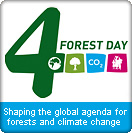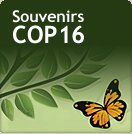COP16/CMP6 Sustainability
In compliance with its obligations as host of the Sixteenth Conference of the Parties to the United Nations Framework Convention on Climate Change (COP16) and the Sixth Conference of the Parties serving as the Meeting of the Parties of the Kyoto Protocol (CMP6), the Mexican government was committed to ensure that participant’s transportation and energy consumption during COP16/CMP6 resulted in the minimum environmental impact.
To ensure that much of the energy used during the event came from renewable sources, hence minimizing the release of greenhouse gases (GHG) emissions to the atmosphere as much as possible was one of the priority goals of the Mexican authorities.
A wind power generator with a 1.5MW capacity, which supplied and continues supplying renewable energy to the power grid of the city of Cancun was installed. Biodiesel-powered buses were available for the transportation of the delegations of the participating countries during the event. In the framework of environmental cooperation between Mexico and Italy, the energy supplied to host the event came from photovoltaic cells that generate up to 130 kW.
The government of Mexico began working with hotels in Cancun, Puerto Morelos, Playa del Carmen and Tulum to promote more efficient operation and generate less environmental impact. With the "Environmental Leadership for Competitiveness Program”, a special counseling program implemented by SEMARNAT, 63 hotels have implemented eco-efficiency projects designed to reduce resource, water and energy consumption. With these projects, the annual water consumption –for example –will be reduced in more than 645 thousand cubic meters, enough to supply for 1,281 families, and the release of about 9,900 tons of CO2 into the atmosphere each year will be avoided.GHG released by the Mexican delegation travelling and transportation before and during the event will be offset by a conservation mechanism called "payment for environmental services." Under this scheme, GHG released by the use of energy during the Conference official meetings, including parallel and cultural events, will also be neutralized.
In addition, the government of Mexico, with private donors, will offset the emissions generated by travel and stay of Non-Annex 1 countries delegations, as well as those produced by the stay of the delegations of the Annex 1 countries. In a first estimate, the volume of these referred emissions is 15 thousand tons, and their commercialization in the Mexican Voluntary Carbon Market will support reforestation and sustainable forest management projects of indigenous and rural communities in 1,250 hectares, paying a rate of about 1,500 pesos per hectare.
In further accordance with the acquired commitments, the Mexican government invited the attendees to COP16/CMP6 to neutralize their own GHG emissions by supporting soil restoration, reforestation and forest management projects carried out in different parts of the world, especially in Mexico.
Carbon footprint
COP16/CMP6 attendees had access, both online and in modules located on site, to a carbon footprint calculator with which they could measure the emissions generated by their air and ground transportation, lodging and meals. Once assessed, participants had the option of offsetting their emissions by selecting one of the projects of the Mexican Voluntary Carbon Market, such as those implemented by indigenous communities in the Mixe, Chinanteca or South and North Mountain regions in Oaxaca, Mexico, or through the Clean Development Mechanism of the Kyoto Protocol.
Specific actions carried out in the city of Cancun
Thirteen kilometers of the Luis Donaldo Colosio Boulevard, Cancun's main artery, were forested to represent reforestation as a feasible tool for atmospheric carbon dioxide capture.
A recycling program was implemented during the Conference. Specially designed trash cans were installed both where the Conference meetings and events were held and in different parts of the city of Cancun. With this program, diverse materials were recovered and incorporated to productions cycle in order to avoid their disposal.
- Welcome to Mexico
- What is COP16/CMP6?
- United Nations Framework Convention on Climate Change
- UNFCCC E-Newsletter
- Cancun
- COP16/CMP6 Venue
- Who can participate?
-
COP16/CMP6 Sustainability
- Quintana Roo: Environment
- Brand terms of use


Page 'Breadcrumb' Navigation:
Site 'Main' Navigation:


















Social Media Links:
Follow us: